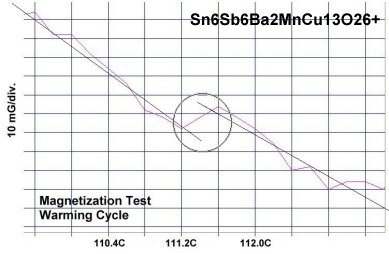
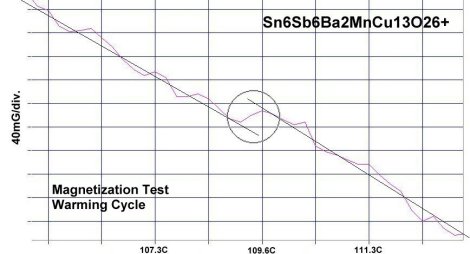


Superconductors.ORG herein reports the successful synthesis of the first compound to exhibit superconductivity above the boiling point of water. Sn6Sb6Ba2MnCu13O26+ displays a critical transition temperature near 110 Celsius (230F, 383K).1 This brings to 21 the number of compounds found to display superconductivity above room temperature.
Confirmation of superconductivity was made using a magnetometer and direct resistance tests of two pellets. Ten magnetization tests produced sharp diamagnetic transitions at an average temperature of 110.0C. Then thirteen resistance tests revealed companion resistance drops at an average temperature of 109.7C. The two plots at page top show examples of the Meissner transitions. The straight lines approximate the average of the data points, skewing apart at Tc, the critical transition temperature.
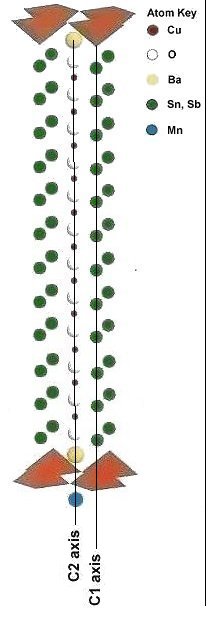
|
Like the 95C superconductor announced in October 2014, this copper-oxide ceramic exploits a high dielectric constant (K) in both the MnO2 anion and SnSb cation layers to complement a high planar weight ratio (PWR) along the C axis. This new formulation features longer chains of tin-antimony in the C1 axis as well as longer copper-oxygen chains in the C2 axis than were used in the J212 structure of the 95C prototype. This results in an exceptionally large unit cell. Using the standard naming convention, the target structure would be classified N212 (shown at left)2. Below are two of the thirteen direct resistance plots. 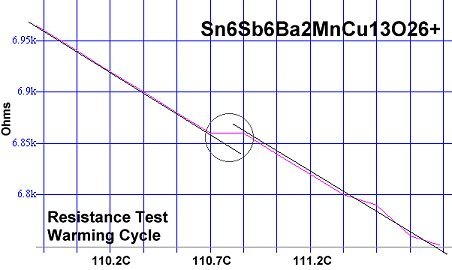
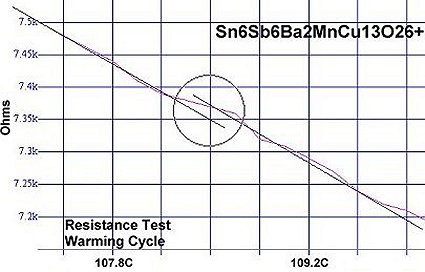
|
The above resistance plots confirm that the associated diamagnetic transitions are Meissner transitions. In the physical sciences there is no phenomenon other than superconductivity that can produce a sharp diamagnetic transition and a resistance drop at the same temperature. Note that the bulk has a negative temperature coefficient, sloping the opposite direction as the superconductive transitions. All of the plots on this page exhibit a low signal-to-noise ratio due to a low volume fraction of superconductive material and a high thermal noise level inherent to these temperatures.
The below graph illustrates how influential dielectric constant (relative permittivity) is in promoting Tc. The dots within the grid are copper-oxides that have a low Kappa. While those in the yellow box are copper-oxides that have a high Kappa. At the same PWR, the curve with the high K compounds features transition temperatures 60 to 70 degrees greater.
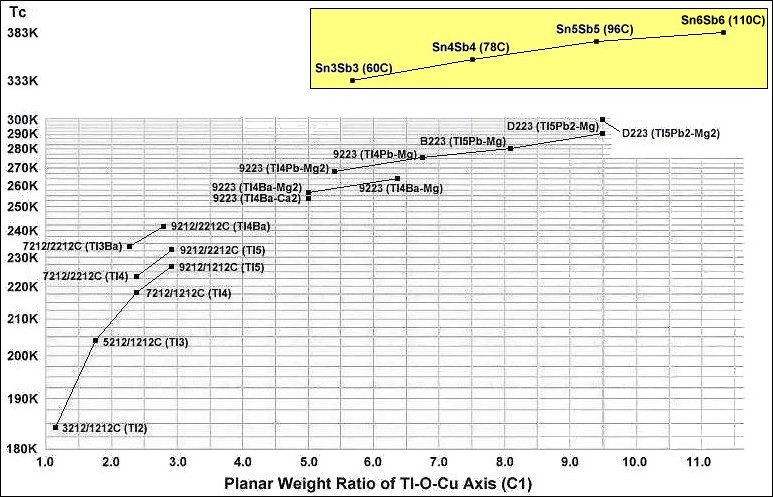
In order to maximize formation of the N212 structure, this compound was synthesized using the layer cake method, as shown below. The pellet had approximately 100 interference layers. And, even using this layering technique, the volume fraction is low, requiring very sensitive test equipment.
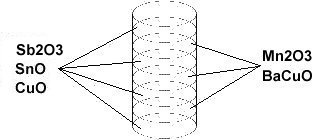
Stoichiometric ratios of the below chemicals were used for the ODD layers:
SnO 99.9% (Alfa Aesar) 5.85 grains...and the below ratios for the EVEN layers.
Mn2O3 98% (Alfa Aesar) 0.57 grainThe chemical precursors were pelletized at 60,000 PSI and sintered for 34 hours at 860C. The pellet was then annealed for 10+ hours at 500C in flowing O2. Temperature was determined using an Omega type "T" thermocouple and precision OP77 DC amplifier. The magnetometer employed twin Honeywell SS94A1F Hall-effect sensors with a tandem sensitivity of 50 mv/Gauss.
RESEARCH NOTE: The copper-oxides are strongly hygroscopic. All tests should be performed immediately after annealing.
RE-PUBLICATION NOTICE: Elsevier Publishing, dba Elsevier Science, as well as Morris Communications, both print and broadcast divisions, are specifically prohibited from re-publishing any part of this news story.
E. Joe Eck
© 2014 Superconductors.ORG
All rights reserved.
1. Testing temperatures are believed accurate within ± 0.5 degrees C. Rapid prototyping trades off
temperature accuracy for speed.
2. The "N" in N212 is a hexavigesimal equivalent of decimal 23.
 BACK to "News" page at Superconductors.ORG
BACK to "News" page at Superconductors.ORG